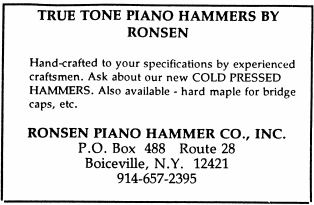|
Tech Tip
by Michael Slavin, Chapter President In older spinets we often encounter broken plastic elbows. Unfortunately the repairs can become difficult if the threaded drop wires are missing or have become lost, which is too often the case. If we are lucky we might have a few extra wires in our toolcase, but this is unlikely, and new wires are usually unavailable. And even if we happen to have a spare replacement, it might be a short one, as they come in different lengths, and therefore not useful for the needed application. One solution is to "cannibalize" elbows and wires from the extreme ends of the action, but this will leave those notes unplayable. Visually they will remain permanently depressed, or if supported at the front rail pin with extra felt punchings to be level, they will nevertheless be "dead." For a long time I have been looking for a good substitute for the original drop wires. Using a micrometer on dozens of samples, I have found that almost all of them measure about .099. If you can find an old wire coat hanger, most are of a thick enough diameter to be cut to length and are a fine substitute. But most new wire coat hangers are much too thin to be of any use. Also, wire mute handles are just about the right thickness, but are almost always much too short. 
|
I have finally found an ideal substitute metal rod for elbow drop wire repairs. All hardware stores carry brass toilet tank lifter rods, and while many are a slightly heavier diameter (usually in the .010 to .012 range), will nevertheless work perfectly in this situation. The toilet lifter rods come in two lengths, sometimes packaged together, but you will need the longer one. Place the new brass rod in a vise before proceeding with any preparation, as the material is quite soft and will bend or deform easily if not fully supported. Using an original drop wire as a gauge, cut the toilet lifter rod to the same size. Indicate the length of the threaded sections on each end of the drop wire onto the new rod with a black permanent marker. Although I have been unable to find a screw die of the exact same fine thread as those on the original drop wires, a 1" / 25.40 6-32 screw die will work just fine. Cut the threads on each end of the brass rod to the appropriate depth. Before installing either a new plastic elbow, or a wooden lifter button or rubber grommet with fiber washer insert onto the new rod, it is advisable to pre-tap these parts using the threads on an original drop wire. Trying to thread the parts directly onto the soft brass usually results in the rod breaking off from the friction; the soft brass is soft and malleable enough to conform to the threads created by the drop wire, although they are not identical. A very small application of Protek MPL solid lubricant can further simplify the threading process. Install the elbow-wire assembly into the piano, and regulate the lost motion. Good as new! Note: If you are substituting a snap-on plastic elbow for an original wooden elbow, you may need to adjust the length of the brass rod to compensate for differences in overall length which will probably exist. |